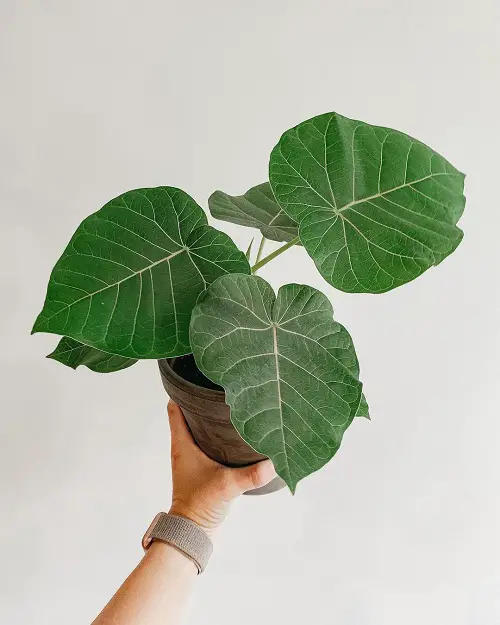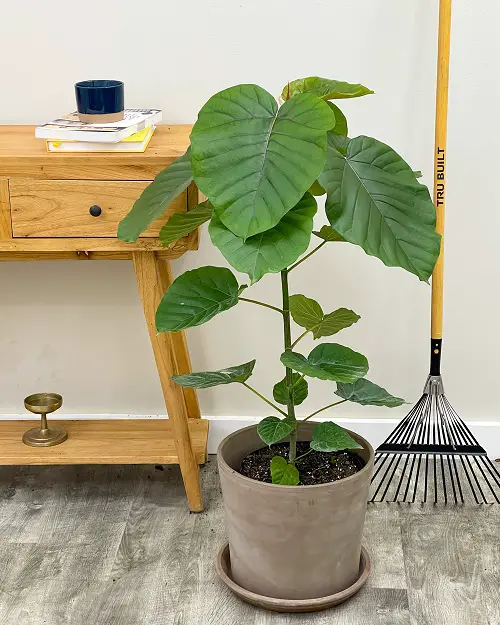Transform your indoor space with the lush and low-maintenance Ficus Umbellata and invite lush tropical vibes to your home!

Looking to add a touch of tropical elegance to your indoor space? The Ficus Umbellata, also known as the Clustering Fig, can be a beautiful and low-maintenance option!
Ficus Umbellata Plant Information
Ficus umbellata is a member of the Ficus family, which includes over 800 species of plants and is native to India and Southeast Asia. This low-maintenance plant is a great option for beginner plant parents.
It can grow up to 3-6 feet tall and wide and can be trained into a tree form or allowed to grow into a bushy shrub.
The Ficus Umbellata is an excellent plant choice for those who want to add a touch of green to their indoor space without having to put in too much effort. With its unique appearance and low-maintenance nature, this plant can bring joy and beauty to your home for many years to come.
Take a look at Ficus pumila quercifolia Growing Guide
Pot Size for Ficus Umbellata

For starting Ficus umbellata, an 8-10-inch pot will be an ideal size. As the plant grows and spreads, keep on re-potting it into a bigger container than the old one.
Propagating Ficus Umbellata
- When propagating Ficus umbellata from cuttings, use a sharp, sterile knife to take a cutting from the tip of a healthy branch. Make sure the cutting is at least 8 inches long and that there are at least two sets of leaves. Dip the cutting in the rooting hormone and then plant it in moist potting soil. Place the cutting in a warm, bright area but out of direct sunlight, and keep the soil moist. It should root in about 6 weeks.
- For propagating Ficus umbellata from air layering, select a healthy branch and make a shallow incision around it. Pack the cut area with moist sphagnum moss and wrap the moss in a plastic bag. Secure the bag with a twist tie and wait for roots to form. Once the roots have developed, cut the branch below the moss and replant it in potting soil.
Requirements for Growing Ficus Umbellata
Light
Ficus Umbellata prefers bright, indirect light. For indoors, place it near an east or west-facing window to ensure it gets enough light without becoming scorched.
Soil
Use well-draining soil with plenty of organic matter. A good mix to use is a combination of one part potting soil, one part peat moss, and one part perlite or vermiculite.
Water
Ensure that the soil is evenly moist but not waterlogged, which can cause root rot. Water your Ficus Umbellata whenever the topsoil feels a little dry to the touch.
Do not water the plant on a daily basis, and also ensure that the growing medium is never going dry completely. Also, keep in mind that the plant is sensitive to overwatering, so it’s better to underwater than overwater.
Temperature and Humidity
Ficus Umbellata prefers temperatures between 60-95°F (15-36°C) and moderate to high humidity levels. Avoid placing it near heating or cooling vents, which can cause stress and lead to leaf drop.
Do not expose the plant to temperatures below 50 F (10-12 C).
Check out the Best Ficus Benjamina Varieties
Ficus Umbellata Care

Fertilizing
Ficus Umbellata appreciates regular fertilizing in order to promote healthy growth. A balanced, water-soluble fertilizer formulated for houseplants, applied according to the manufacturer’s instructions, is usually all that is needed.
You can also dilute the feed to 1/4 of its strength and apply it every 4-5 weeks. Do not feed the plant during winter months as it is dormant.
Pruning
Regular pruning can help maintain the shape and size of the plant. You can also remove any dead or yellowing leaves and stems.
Remember to use sharp, clean pruning shears to avoid damaging the plant.
Pests and Diseases
Ficus Umbellata is susceptible to a range of pests and diseases, including spider mites, mealybugs, and scale insects. Regularly inspect your plant for signs of infestation and take action immediately if you notice any problems.



